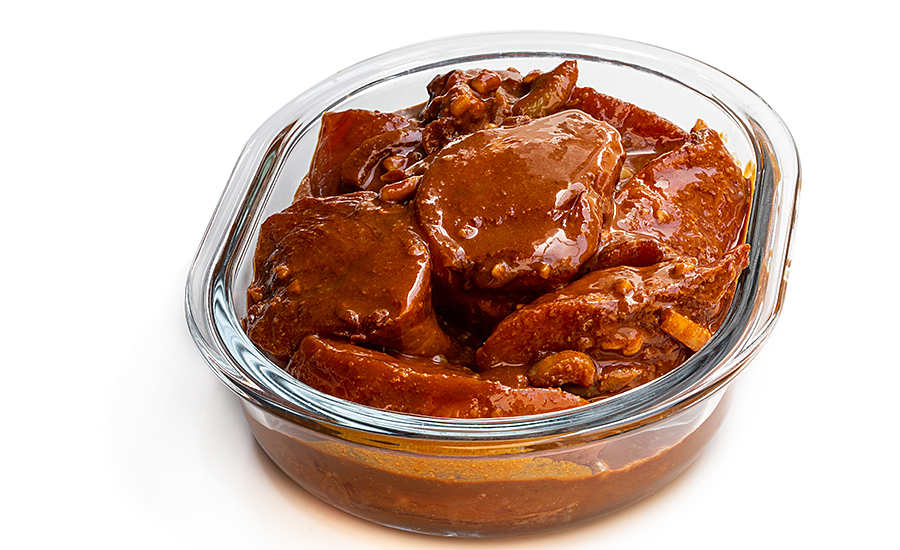Simple isn’t easy.
A lot of work goes into a “clean label,” particularly with marinated proteins. To achieve the ever-popular clean label, processors have had to re-think more than marinades’ ingredient composition, functionality and chemical reactions, but also improve natural sanitation, injection equipment and filtering technology.
“In the past few years, suppliers have worked to provide ‘all-natural’ and ‘clean-label’ ingredients with functional benefits and have removed or reduced the impact that the ingredient components impart to flavor,” says Gary Dunlap, research and development and commercialization director at Clemens Food Group, in Hatfield, Penn.
The shift toward simpler labels has resulted in fewer ingredients and more natural microbial inhibitors for improved shelf life and food safety. Ingredient companies are coming out with new ingredients such as phosphate replacements labeled as spices and citrus extract or as natural flavors all the time, says Brett Erickson, director of value-added products for Certified Angus Beef brand, in Wooster, Ohio.
“Dry vinegar and extracts of rosemary, grape seed and cherries are ingredients consumers recognize,” says Erickson. “Ingredients like these are as effective as traditional synthetic ones so our processors continue to gain confidence in them.”
The improved efficacy of natural antioxidants, antimicrobials, flavor enhancers and functional ingredients has made this change possible.
“In the past 10 years, there has been a developmental bonanza of natural alternatives to MSG, nitrite and other synthetics,” Erikson says.
Ingredient suppliers have worked to improve the solutions they can offer to processors. “Ingredient suppliers have been creating more customized solutions for use in products, to maximize performance of the products through production and to the consumers’ experience with the product,” Dunlap says.
IMPROVING INJECTION AND TUMBLING EQUIPMENT
Innovations are also centered on new technologies in sanitizing and the use of natural ingredients. “Newer technologies allow for sanitizing injectors with natural sanitizers while in production,” Erickson says. “That’s incredible for food safety.”
More attention to the sanitary design of equipment has led to improvements in efficiencies, product performance and shelf-life improvement, Dunlap says.
Equipment manufacturers have been improving the standard deviation of their injection equipment to reduce the variability in injected products. “In addition, there have been many advances in the filtering technology for some of the equipment manufacturers provide,” says Dunlap. “We have seen improvements in the performance of products through the application of the innovations our ingredient and equipment suppliers are providing.”
According to Erickson, most of the Certified Angus Beef processors are moving away from injecting, except for cooked deli meats and fresh corned beef. “They are tumbling and incorporating more natural ingredients for cleaner, simpler labels,” he says. “They’re creating flavor profiles that accentuate the quality of our beef.”
Sanitation and temperature control are the major safety factors in tumbling and injecting marinades, says J. Byron Williams, Ph.D., associate extension/research professor of muscle foods at Mississippi State University, in Starkville, Miss.
Spray injection is becoming more popular, as opposed to using a single needle with one opening, which can leave traces of marinade in the needle injection pathways in the muscle tissue, Williams says.
“Spray injectors have a smaller opening in their needles, which creates atomization of the marinade so it can find more spaces and locations between muscle fibers and bind to more protein sites with less drip and yield loss,” he says.
In addition, injector heads can be interchanged very quickly to enhance the cleaning process and changeover time, Williams adds.

DELIVERING FLAVOR AND CONVENIENCE
Along with tumbling and spray injection, the addition of external flavors and spices to marinades can make them more user friendly.
“Some spices or dry marinades, however, cannot be totally dissolved,” Williams says. “So, if the flavor profile calls for such a spice, the product can be injected, tumbled for a while, and then the ground or cracked spices can be added — such as with pork tenderloins and some poultry cuts. The tumbling effect helps to bind the ground spices to the surface.”
New flavors and combinations are being developed daily that are pleasing to consumers, Williams says.
“There has been a move away from using HFCS (high-fructose corn syrup) or any corn syrup or any preservatives at all in marinades,” says Tony Cimolino, chief marketing officer for Golden West Food Group, in Vernon, Calif. “Kettle-cooked marinades add better flavor delivery.”
Consumers are seeking simple ingredients and multicultural flavors in their at-home meals. Among their favorite flavors are Latin, Asian, Korean and traditional American, Erickson says.

ACHIEVING THE SAME RESULTS OF SYNTHETICS
Over the past 10 years, consumer demand for less complex ingredients is challenging the industry to look at a variety of natural ingredients to achieve the same efficacy of synthetics, says Erickson.
Phosphate replacement remains the greatest challenge, in terms of having a cost-neutral solution that replaces all of the functions of phosphates in marination and injection, Dunlap says.
“There are ingredients that can replace one or two of the functions, but we still need to formulate with other added ingredients for the replacement of other functions,” says Dunlap. “The cost in use of the combined ingredients is typically greater than that of the phosphate in the original formulation.”
As more ingredients are included in injections and marinades, the issue of traceability — and allergen labeling — has never been more important. Proposed U.S. Food and Drug Administration (FDA) recordkeeping regulations mandate more traceability requirements, so developing a fool-proof system to track ingredients is crucial, Williams says.
Antimicrobials promise to improve product quality, safety and yield. “But you have to be cognizant of their chemical reactions on product performance,” Williams says. “As we push for enhanced shelf life and a smaller number of organisms on the product — as we are touching and manipulating product more — antimicrobials can enhance meat safety.” NP





Report Abusive Comment